A brewer on Gotland
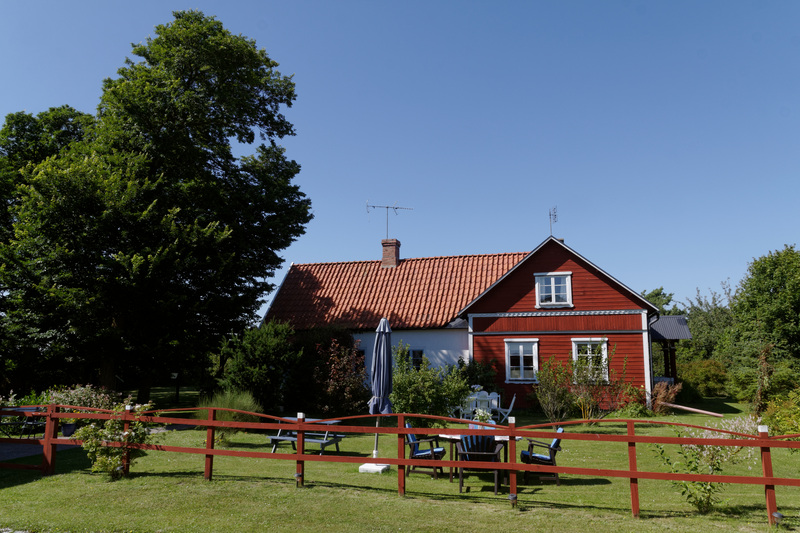
The farm, Hablingbo, Gotland |
Last summer, the family holiday included a visit to Gotland. I, of course, immediately started plotting to meet a farmhouse brewer. I began by emailing every single source that might lead me to one. This was a slow and uncertain business, but eventually I had a number of leads, all of them pointing to a single person: Anders Mattsson in Hablingbo, on the southern part of the island.
Anders did not answer email, however. Nor did he pick up the phone. Other contacts were surprised by this, and told me to keep trying. Eventually, one afternoon in May, Anders did answer the phone. Yes, he'd been having trouble with his email, and he'd been on holiday in Spain. Yes, he did brew, and sometimes gave brewing courses. We eventually agreed that I could come and brew with him. I started emailing people in December, so getting this far took me six months.
Then, a couple of days before I was supposed to visit him, Anders called. Some other obligations had come up, so we couldn't brew, but I could still visit him, and he'd give me his recipe. "I think you will be well satisfied," he finished.
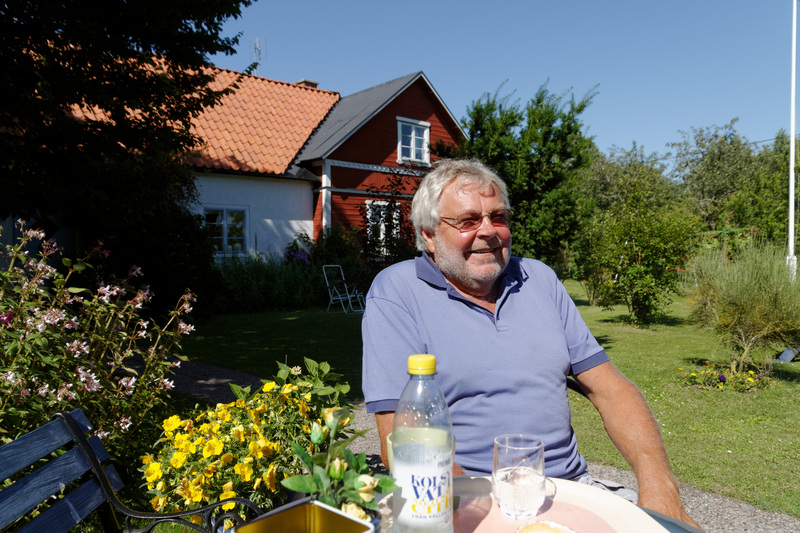
Anders in his garden |
Finally, the big day arrived, and I drove south to Hablingbo, through forest and farm country. Anders's farm looked much like the others in the area: idyllic wooden house, big gardens, an old wooden barn. I parked in the yard, and before long Anders came to greet me. He was very friendly, but his Gotland dialect was a bit tricky for me to understand. No doubt my Norwegian was equally difficult for him, but somehow we managed.
Anders learned to brew a little from his father, but mostly from his uncle, who also left him the farm he's living on now. People used to brew in wooden tuns, but they brewed so often that the vessels never dried. That meant they didn't have to wet the vessels to make them swell out and seal any leaks. Now, however, he uses steel equipment. A potato cooker from the army, a steel mashtun, and milk cans.
He mashes with juniper infusion, which he boils. He uses fresh juniper twigs, with berries, but not too many berries. Then he pours the boiling infusion onto the malts in the strainer. The bottom of the strainer is lined with 2-3 juniper branches to act as the filter. He doesn't know the mash temperature, because he doesn't use a thermometer. Since we didn't brew together, I don't know the mash temperature, either.
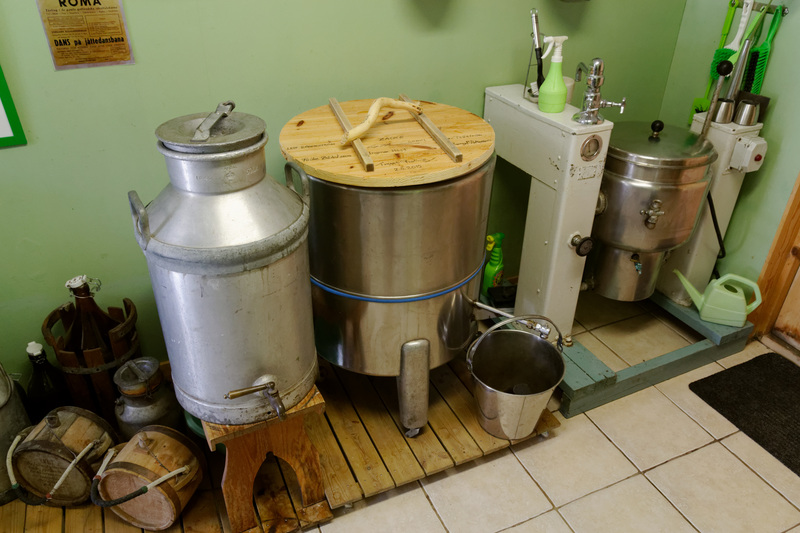
The brewery |
He buys the malts from a farmer who makes his own malts in the traditional way. Anders says there are 2-3 farmers still malting their own grain in the south end of the island. Some brewers, however, buy commercial malts in the shop. The traditional malts are smoked with alder wood, just like in Stjørdal. Some people mix the traditional malts with commercial malts, to reduce the smoke flavour. The traditional malts are also a little variable. Anders tells me people often say "Dricke is dricke, you never know what way it's going to turn."
"Dricke" literally means "drink," but in this context it means beer, and specifically the local traditional beer, gotlandsdricke. My guess is that the Swedes use this term because small beer ("svagdricka") was traditionally the most common drink against thirst in Sweden. (No, this was not the case in all the Nordic countries. More about that later.)
In the summer he mashes only an hour, because otherwise the beer can easily go sour. In winter he mashes longer. Once the mashing is done he starts the running from the tap sticking out of the mash tun. The running wort must form only a thin stream. His grandmother taught him it should be "like a woman's piss." He tilts his head, looking at me. "She said so, in all seriousness," he adds pensively, as if wondering what could have made his grandmother say such a thing.
He uses the word "lännä" for the wort, which is an odd word. In Norway it's generally called "vørter", "virkje" and so on. In Denmark "urt". In Sweden it's generally "vört." All obviously from the same root as "wort". Where "lännä" comes from I can't say.
The running takes a long time, because it's so slow, so this is a kind of pause in the brewing. "Then we can sit around lying," Anders says. I assume he means the brewer will be exchanging tall tales with whoever is around.
On Gotland many people drink "kaffehalva" (coffee-half), which is strong liquor in coffee. A relative of Anders's hit upon the idea of "lännähalva" (wort-half), which is strong liquor in the hot wort coming straight from the strainer. That actually sounds like it would be really nice, especially in winter. Anders says it's really caught on and spread all over Gotland.

The milk cooler |
Since the malts are home-made it's difficult to judge how strong his beer is, so I try to ask if he's ever tried to measure the sugar content. Anders just shakes his head. "That scientific stuff is not for me," he says.
In the winter he will cool the wort by simply setting the milk cans outside. In summer he uses a milk cooler. This is just a special lid for the milk cans with a u-shaped pipe running down into the liquid, with openings on top to run cold water through the pipe, which makes it rotate. This is pure genius. So simple, and so effective, allowing the wort to be cooled with the lid on to protect it against infection.
Anders shows me his three ladles, which he uses during brewing. The big one is called Silte, he says, after a nearby village where people are known for drinking a lot. The mid-sized one he calls Hablingbo (that's where he lives). The small one is for children and tourists, he says, smiling.
He uses Swedish baking yeast, which he pitches at 23 degrees. He uses very little, just enough to cover his thumbnail for 50 liters of beer, so he clearly underpitches. He then lets it ferment for a week before racking. The beer tastes best 2-3 weeks after fermentation began, but some people keep it for 1-2 months. "Then it tastes more like wine," he says. I assume he means that it goes acidic.
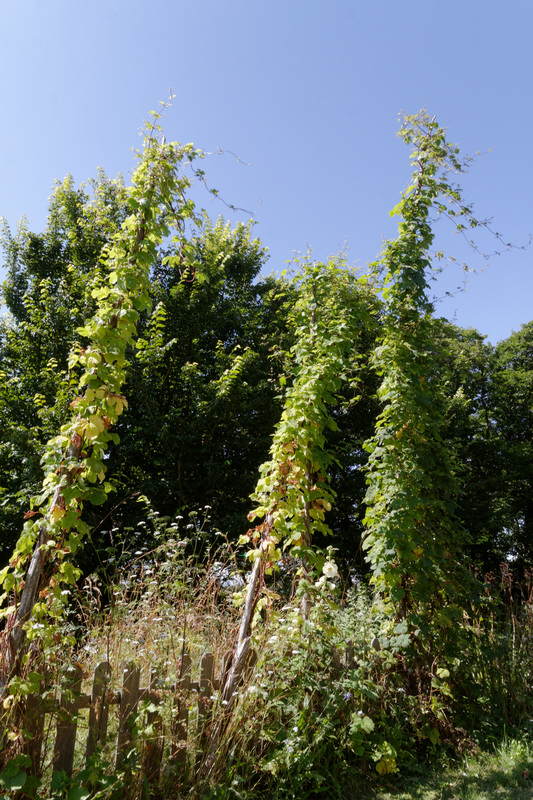
Anders's hop garden |
Which reminds me: what about the boil? Anders boils the hops in 2-3 liters of wort, which is just enough wort to cover the hops. The hops come from his hop garden right behind the brewery. He shows me the hop plants climbing along tall wooden poles. Some of the plants come from his wife's home farm, and some from another farm.
So this is very clearly a raw ale. Anders says that everyone in Hablingbo does it this way, adding that "the dricka never has time to go sour." Does that mean that all Gotlandsdricka is raw ale? No. I'll get back to this in a later post.
It's at this point Anders admits to having drunk all the beer, so that there's none left for me. However, when he gives courses he sometimes produces more beer than he really wants. When this happens he'll fill the excess wort onto plastic cans and put them in the freezer. If he later wants some beer he'll just thaw up the wort, and pitch some yeast into it. He did that a few days ago, so that he could get some beer for me to taste.
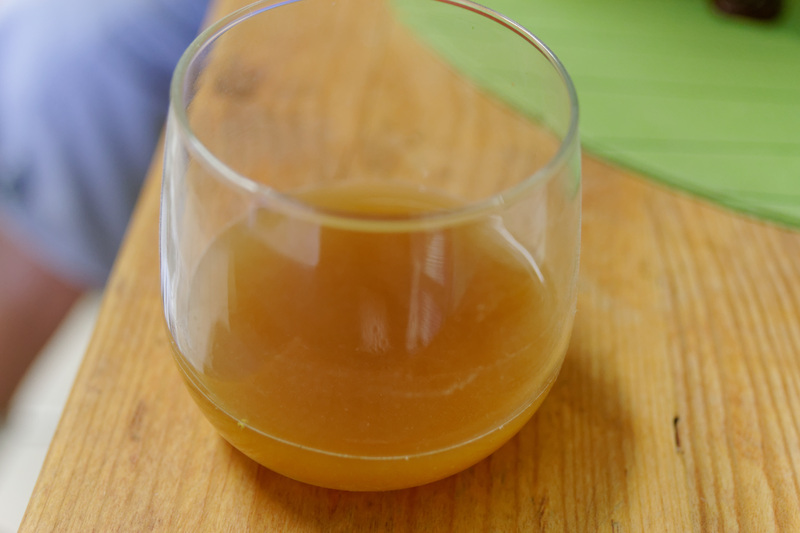
My sample of Gotlandsdricka |
Anders, knowing full well that I intend to leave by car, brings out a small glass and serves me a tiny amount of beer. It's hazy, pale yellow, with very little carbonation. In the mouth it has an incredibly soft mouthfeel, very smooth, with a clear alder smoke flavour, and the green flavours of raw ale. There's no hop aroma, and hardly any bitterness. It's clearly a little green still, but by any standard it's an excellent beer. I stare at the plastic can with longing, but I'm driving, so...
Once we'd gone through the brewing process and I'd tasted the beer we were ready for coffee. We settled down by a table in Anders's garden, eating cake, drinking coffee, and chatting. It turns out there are quite a few brewers on the island, and brewing has seen something of a revival since the 70s. Brewing died out on the northern island of Fårö, but was since revived.
However, now the tide has turned again, and the brewing is clearly declining, Anders says. I ask him how many people brew nearby. "Hmmm," says Anders, "let me count quickly." Pause. "Ouch, what loss," he exclaims. There are maybe 8-10 brewers now in Hablingbo, he says.
Once the coffee and cakes are consumed I get up to leave, but Anders takes me on a detour into the brewery to show me something. He holds up an intricate ring made of interlocking wooden pieces, and asks me if I know what it is. He's astonished when he finds that not only do I know what it is (a yeast ring), but I've even seen one used for real. For my part I'm surprised to find one showing up in Sweden. I thought it was a Norwegian thing.
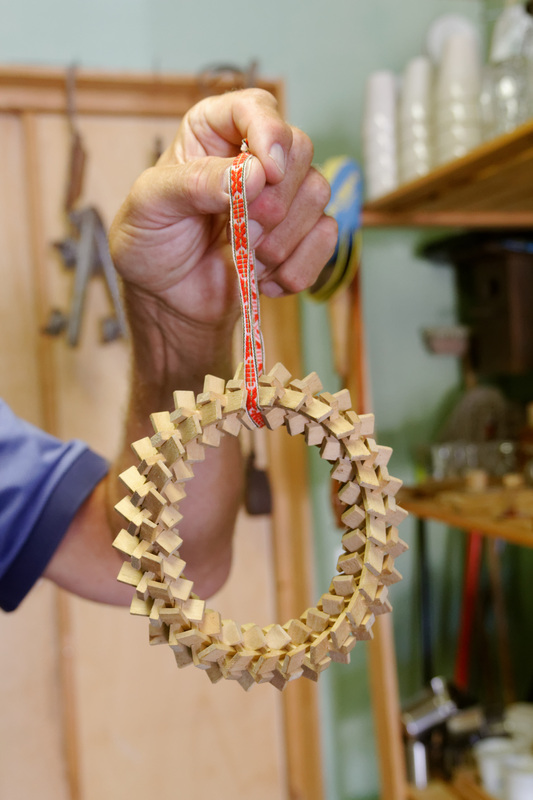
Yeast ring |
And on that note I take my leave, and get back in the car, to drive 10 minutes to visit another brewer.
Recipe
Anders gave me his recipe, which I reproduce here. It's for 50 liters of gotlandsdricka.
Ingredients:
- 12-15kg of malts (this is pale, lightly alder smoked malts, probably of relatively low efficiency, let's say 60%)
- 2-3kg of white sugar
- Juniper branches (this is Juniperus communis, as usual, with berries, but not too many)
- 200g of hops (this is Anders's own, but noble hops should work)
- 1 thumbnail of baking yeast
Put the branches in the water, then boil them. Pour about 5 liters into the mash tun, then add the malts and stir thoroughly. Add more juniper infusion if necessary. Leave it for at least an hour. (No, I don't know the temperature.)
Put fresh juniper branches at the bottom of the lautering tun. (It's a good idea to dip these in boiling juniper infusion first.) Transfer the mash on top of these. Run off about 10 liters of wort, then pour it back on top to filter it again. Then run off wort very, very slowly. (At this point Anders recommends celebrating with a cup of hot wort mixed with some hard liquor.) Add more juniper infusion on top as needed.
No, I don't know the OG. Nor the FG. However, if we assume the hops have 3% alpha acid, which seems reasonable, then the beer should be about 26 IBU.
Take 2-3 liters of wort and boil the hops with those for an hour.
Once everything has been run off you can stir in the sugar, and add the wort boiled with hops. Cool to 23C, and pitch the wort. Let it ferment for a week before transferring to a cold place (10-15C). It will keep about 2-3 months.

Windmill at Hablingbo, Gotland |
Similar posts
Gotlandsdricke - an overview
A lot has been written on Gotlandsdricka, but the writers generally call it "an ancient beer" or "indigenous beer" and variations on that theme
Read | 2017-01-08 13:24
A maltster on Gotland
While on holiday on Gotland I saw a note on a poster about an open farm and something about malt being made
Read | 2017-01-01 14:02
The juniper mystery
When I started looking at farmhouse ale back in 2010, one of the first things that struck me was that nearly everyone seemed to be using juniper
Read | 2017-02-02 09:43
Comments
Nils Dahl - 2016-12-30 14:03:34
I was looking for something on Gotlandsdricka or any other Swedish farmhouse brew, and was just thinking of asking you to write a piece. Thanks for this, and keep up the great work.
I was thinking that if he boiled the hops in a very small amount of wort, the alpha-acid extraction would have been pretty poor. Brewer's friend has it at about half of the 26 IBUs you estimated, which seems like a reasonable guess. Does that match up to what you tasted?
Lars Marius Garshol - 2016-12-30 15:06:53
There's two more blog posts coming on Gotlandsdricke, so there will be a little more info in a few weeks. Regarding the rest of Sweden I hope to get my hands on the Swedish farmhouse brewing survey responses in February. So later on there will be something much more substantial on Sweden in general.
Yes, I've been expecting low extraction from these people boiling hop tea, but I didn't find a formula that takes that into account. 13 IBUs is closer to what I think I tasted than 26.
Ben Coli - 2016-12-31 00:15:51
I love this. Drinking the first runnings of wort mixed with hard alcohol is something of a tradition among the craft brewers here in Vancouver, Canada. When two or more breweries get together for a collaboration brew, we often have a nice hot, boozy drink in the morning. Here it's usually called a "hot scotchie", presumably after Scotch whisky, although I've never had it with scotch. It can be really nice with rye whisky, bourbon or rum, though.
Martyn Cornell - 2016-12-31 10:17:12
Excellent and fascinating as usual, Lars. Very interesting to see those hop poles, just like 19th century illustrations. I note that at 57 degrees 30 north, Gotland is outside the "recommended" latitude for successful hop growing of no higher than 55 degrees north: I wonder what difference being that little further north makes. I greatly look forward to more!
Lars Marius Garshol - 2017-01-01 06:11:21
Thank you, Martyn. The next brewer had exactly the same hop poles, and old ethnographic photos from the 1920s and 30s show the same setup elsewhere in Sweden. Althought it seems commercial growers used a different system.
What the effect on flavour is is hard to say, as I've only had a few beers made with hops grown this far north. In Gotland it doesn't matter much, because there seems to have been no hop flavour to the beer, anyway.
Hops have been grown much further north than 55N, though. It was grown in most of Norway up to about 66 degrees north. The same appears to have been the case in Sweden.
Mika Laitinen - 2017-01-02 13:30:55
Great story! Nice to read updated info on this ale. I thought that Gotlanders use birch to smoke their malts. Do you think there is a preference for a certain smoking wood?
I can confirm that also in Finland hops grow up around 66 degrees north. I'm trying to figure out if there are some special brewing characteristics in landrace Finnish hops, but I'm far yet. It is very difficult to tell apart the effect of variety, latitude and way of growing and handling hops.
Lars Marius Garshol - 2017-01-02 13:37:30
@Mika: As you see in the following blog post (about the maltster) some also use birch. I think most of those who smoke the malts have a preference, but they don't necessarily prefer the same wood. I'll return to this in the next blog post.
Interesting about Finnish hops at 66N. Maybe that's a northern limit? I have a report of hops growing at 67.3N in Norway, but I haven't checked how reliable it is.
Tailor von Schmitt - 2017-01-13 20:49:12
Mr Garshol, looking at this yeast ring, apart from the desing being much like those in Norway, the wood used seems to be the same. Is there a specific wood to make a yeast ring or a Kveikstokker?
Lars Marius Garshol - 2017-01-14 04:19:02
@Tailor: I don't think everyone necessarily used the same wood, but birch seems to have been popular for the yeast rings. For the logs I have less information, but I know some preferred woods with crinkly bark, and left the bark on so it would collect the yeast.
Ken Keenan - 2018-06-23 18:47:19
Just a random visitor from Ireland with an interest in brewing. I saw your comment about the mysterious word "lännä". I wonder if it could be a loan from Irish? "Leann" is the Irish word for ale https://www.teanglann.ie/ga/fgb/leann
Lars Marius Garshol - 2018-06-24 09:29:51
@Ken: That's an interesting suggestion. It's not impossible. The vikings had Celtic slaves raided in the British Isles. It would be mildly odd for the word for beer transforming into that for wort, but this is still the best explanation I've seen so far.
Nate Dexter - 2018-07-17 16:12:37
From my limited understanding, Gotlandic dialects of Swedish have several divergent words owing to the influence of Old Gutnish, which linguists consider a separate branch form Old West Norse or Old East Norse. Could "Lännä" have a related term in other Baltic languages?
Jose Cabaña - 2020-09-15 13:20:10
Hola como estas? lei tu articulo y me interesa conocer mas acerca de este proceso. Iba a hacer el mismo trabajo de enviar correos a cada granjero en Gotlands para conseguir la receta y me ahorraste un paso enorme! Gracias! Has probado hacer la receta expuesta en el blog?